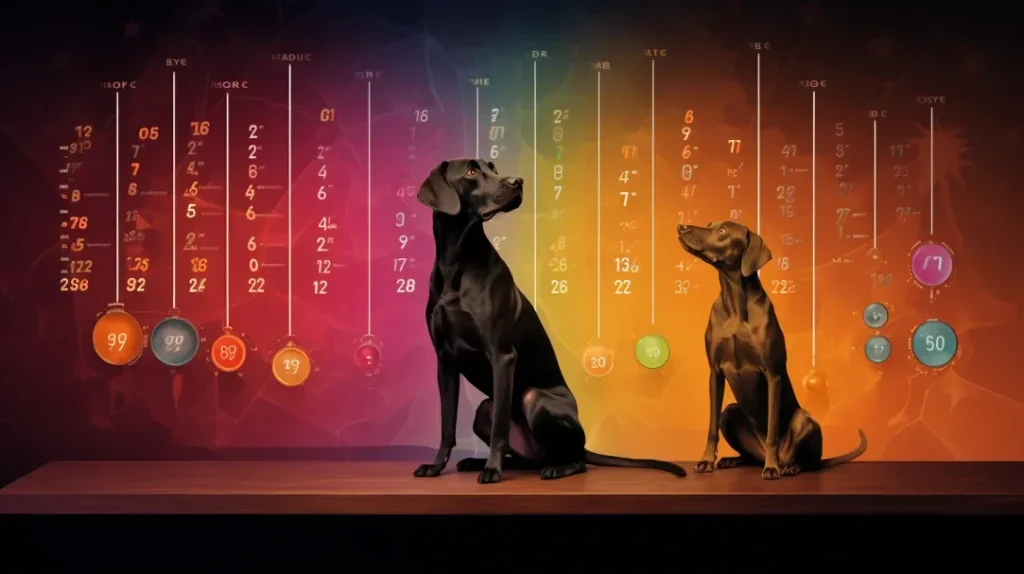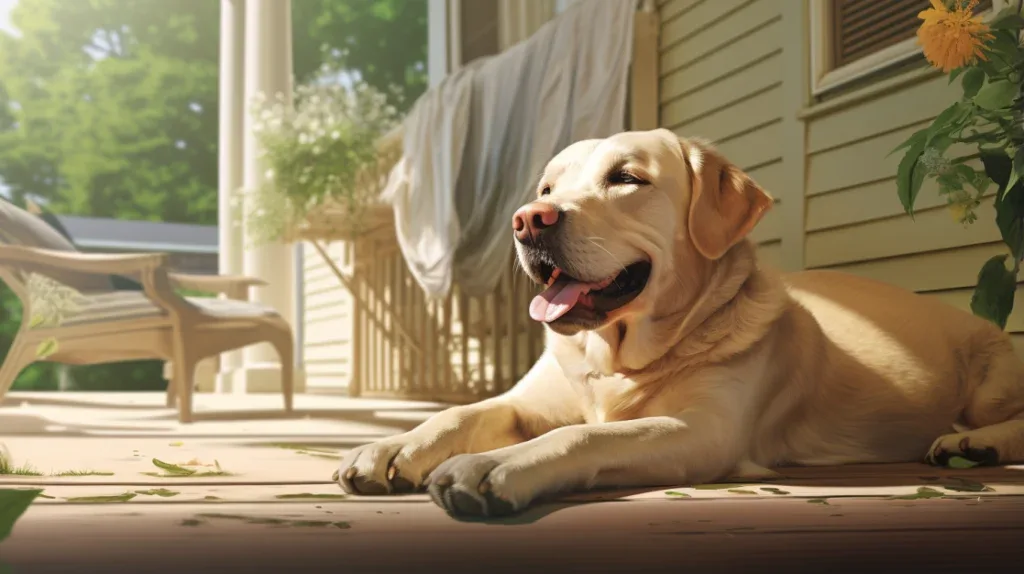Do you know how long your dog’s heat cycle lasts? Can you recognize the signs and symptoms?
Understanding these aspects is crucial to safeguarding your beloved pet against the dangers of heat stroke.
This article will provide you with relation between dogs and heat, all the information you need to navigate your dog’s heat cycle. From understanding its duration to recognizing the warning signs, we’ll share expert tips on prevention and management.
Stay informed and keep your furry friend safe during their heat cycle journey.
Key Takeaways
- The heat cycle, or estrus, is a natural reproductive process in female dogs that typically lasts 2-4 weeks.
- The duration of the heat cycle can be influenced by factors such as breed, age, and individual differences.
- The heat cycle consists of stages: proestrus, estrus, diestrus, and anestrus, each with different signs and durations.
- Managing the heat cycle by providing a calm and secure environment, monitoring behavior and physical changes, and preventing unwanted pregnancies is essential. Additionally, steps should be taken to safeguard against heat stroke by providing shade, access to fresh water, and avoiding excessive exercise during hot weather.
The Heat Cycle: An Overview
A dog’s heat or estrous cycle is an essential reproductive event that female dogs go through. It can last for an average of three weeks but can vary from individual to individual.
During this time, there are distinct stages that a female dog goes through. The first stage is proestrus, where estrogen levels rise, and the dog may exhibit signs like a swollen vulva and a bloody discharge. This stage typically lasts for about 9-10 days.
Next comes the estrus stage, which is the fertile period. Estrogen levels continue to rise, and the discharge becomes lighter in color. The dog may show more interest in male dogs and may even allow them to mate. This stage usually lasts for around 5-7 days.
After the estrus stage, the dog enters the diestrus stage, where her reproductive system returns to normal. If fertilization occurs, she may experience a false pregnancy. This stage can last for up to 10 weeks.
It’s crucial to take precautions during the heat cycle to prevent heat stroke, especially in hot weather. Keep your dog in a relaxed, air-conditioned environment, and always provide access to fresh, cool water. Limit physical activity and avoid direct sunlight. If you suspect heat stroke, immediately cool your dog down with damp towels or ice packs or by offering cool water to drink.
Understanding your dog’s heat cycle is essential for managing her reproductive health and preventing unwanted pregnancies. By being aware of the duration, signs, and how to safeguard against heat stroke, you can ensure the well-being of your furry friend in warmer weather.
Understanding the Duration of Your Dog’s Heat Cycle

When understanding your dog’s heat cycle, it is essential to know the different stages involved, the length of each step, and how to manage it effectively.
The heat cycle typically consists of stages: proestrus, estrus, diestrus, and anestrus.
Proestrus can last anywhere from 7 to 10 days, while estrus usually lasts around 5 to 9 days.
It is crucial to know these stages and their durations to properly handle your dog’s heat cycle and ensure her well-being.
Heat Cycle Stages
During the heat cycle stages, your dog’s body goes through various hormonal and physical changes. It is essential to understand these stages to care for your dog during this time correctly.
Here are the three main stages of your dog’s heat cycle:
- Proestrus: This is the first stage of the process and typically lasts around nine days. During this stage, you may notice vaginal bleeding, swelling, and increased urination.
- Estrus: This second stage usually lasts about 9-10 days. Your dog will be most fertile during this time and may exhibit more signs of interest from male dogs.
- Diestrus: This is the final stage, lasting around 60-90 days if pregnancy does not occur. Your dog’s hormone levels will return to normal during this time.
Length of Each Stage
Knowing the length of each stage of your dog’s heat cycle is crucial for anticipating her needs and ensuring her comfort throughout this natural process. The heat cycle, or estrus, consists of four distinct stages: proestrus, estrus, diestrus, and anestrus.
- First-stage proestrus lasts 9–10 days. Hormonal changes prepare the body for breeding.
- Following proestrus is estrus, the reproductive time. It lasts 5–9 days and causes behavioral changes including increased fondness for male dogs.
- Diestrus follows estrus and can last approximately 60 to 90 days if pregnancy does not occur.
- Finally, anestrus is a resting phase that can last anywhere from several months to a year before the cycle begins again.
Understanding these stages and their durations allows you to manage your dog’s heat cycle better.
Managing Heat Cycle
Managing your dog’s heat cycle is essential for her well-being and a comfortable experience. It is important to take certain precautions to ensure her safety.
Here are three key ways to manage your dog’s heat cycle and keep her safe:
- Provide a calm and secure environment: Create a quiet space where she can rest undisturbed, away from potential stressors or other animals.
- Monitor her closely: Monitor her behavior and physical changes, such as increased urination or swelling in the vulva. This will help you anticipate when she may enter the fertile stage of her cycle.
- Prevent unwanted pregnancies: If you do not plan on breeding your dog, keeping her away from intact males is crucial by using proper confinement measures or considering spaying.
Recognizing the Signs of Heat Cycle in Your Dog

You should be aware of several behavioral changes during your dog’s heat cycle. These include increased restlessness, frequent urination, and heightened attention from male dogs.
Additionally, observing any physical symptoms that may indicate potential health issues, such as excessive panting, loss of appetite, or vaginal discharge, is essential.
Behavioral Changes During Heat
Have you noticed any behavioral changes in your dog during her heat cycle? It’s not uncommon for dogs to exhibit specific changes in behavior due to hormonal fluctuations during their heat cycle. Understanding these behavioral changes can help you better care for your dog during this time.
Here are three common behavioral changes to look out for:
- Increased restlessness: Your dog may become more restless and anxious than usual. This is a result of the elevated hormone levels affecting her mood.
- Aggression or irritability: Some dogs may display aggression or irritability towards other animals or even their human family members. This is a natural instinctive response triggered by the hormonal changes.
- Increased urine marking: Female dogs in extreme heat often mark their territory more frequently by urinating in different spots around the house or yard.
Physical Symptoms to Observe
It’s essential to be aware of the physical symptoms that your dog may exhibit during her heat cycle. This will help you observe any changes in her body and ensure her well-being. During this time, you may notice swelling and discharge from her vulva, which are typical signs of being in heat. Additionally, your dog’s nipples may become more prominent, and she may urinate more frequently. Some dogs also experience behavioral changes such as increased restlessness or clinginess.
It is crucial to closely monitor these symptoms throughout the heat cycle, which typically lasts around three weeks. Observing these physical changes, you can better understand your dog’s reproductive health and take necessary precautions to prevent complications like heat stroke.
Now, let’s discuss how to prevent heat stroke in dogs during their heat cycle.
Preventing Heat Stroke in Dogs
Shade and fresh water are crucial for preventing heat stroke in dogs. Due to their limited sweating, dogs are more susceptible to heat stroke than people.
Here are three practical ways to prevent heat stroke in your furry friend:
- Keep them hydrated: Always ensure your dog can access clean, cool water throughout the day. Add ice cubes or freeze a water bowl for an extra cooling effect.
- Provide shade: Make sure your dog has a shaded area to rest and escape the direct sun. This can be achieved by using umbrellas and awnings or setting up a small tent in your yard.
- Use cooling techniques: Help regulate your dog’s body temperature using wet towels or bandanas on their neck, chest, and paws. You can also invest in cooling mats or vests specifically designed for dogs.
Safe Practices During Your Dog’s Heat Cycle

During your dog’s heat cycle, monitor their behavior closely and provide them with a comfortable and quiet resting space. This is crucial for their well-being and helps prevent potential complications like heat stroke. Heat stroke can occur when a dog’s body temperature rises rapidly and exceeds its normal range. To ensure your dog stays safe during this time, it is essential to understand the signs of heat stroke and take necessary precautions. The table below outlines some critical practices to safeguard against heat stroke during your dog’s heat cycle:
| Safe Practices During Dog’s Heat Cycle |
|---|
| Monitor behavior closely |
| Provide a comfortable resting area |
| Keep the environment cool |
| Offer plenty of fresh water |
| Avoid strenuous activities |
Heat Cycle Management: Tips and Tricks
Explore some helpful tips and tricks for effectively managing your dog’s heat cycle.
It is essential to understand that during this time, your dog may experience changes in behavior and physical discomfort. By following these guidelines, you can ensure that your furry friend stays healthy and happy.
Grooming Techniques:
- Regularly brush your dog’s coat to remove excess fur, helping them stay calm.
- Consider trimming their hair shorter to prevent overheating.
- Avoid using hot water during baths as it can raise their body temperature.
Exercise Recommendations:
- Limit vigorous exercise during the heat cycle.
- Opt for shorter walks or play sessions in more excellent parts of the day.
- To keep them hydrated, provide plenty of fresh water before, during, and after exercise.
Seeking Veterinary Care for Your Dog’s Heat Cycle

Make sure you schedule regular check-ups with your veterinarian to ensure the health and well-being of your dog during their heat cycle. Veterinary care is crucial in managing your dog’s heat cycle effectively.
Your veterinarian will be able to provide you with valuable information about the duration and signs of your dog’s heat cycle, as well as any potential health concerns to watch out for. They can also advise you on the best methods for safeguarding against heat stroke, a severe risk during this time.
Your vet can monitor your dog’s health and handle heat cycle difficulties with regular checkups. Veterinarian treatment can keep your dog healthy and comfortable throughout this crucial reproductive season.
Frequently Asked Questions
How long do dogs stay in heat and bleed?
Female dogs typically stay in heat, also known as the estrus cycle, for about 2 to 4 weeks. The bleeding phase, or proestrus, usually lasts for 7 to 14 days within that period.
What are the risks of dogs and heat stroke?
Heat stroke in dogs is a severe condition that occurs when a dog’s body temperature rises excessively due to exposure to high temperatures or physical exertion. It can lead to organ damage or even death if not treated promptly.
How often do dogs go into heat?
Dogs usually go into heat, or the estrus cycle, every 6 to 8 months, although this can vary depending on the individual dog and breed.
How long are dogs on heat and bleeding?
Dogs are on heat, or in estrus, for about 2 to 4 weeks. The bleeding phase, or proestrus, typically lasts for 7 to 14 days within that time frame.
What should I do to prevent dogs from heat exhaustion?
To prevent heat exhaustion in dogs, avoid exposure to high temperatures, provide plenty of fresh water, never leave them in a hot car, and be cautious when exercising them in hot weather. Watch for signs of heat exhaustion like excessive panting, drooling, and weakness, and seek immediate veterinary attention if these signs appear.
Is It Normal for a Dog to Have a Heavier or Lighter Flow During Different Heat Cycles?
During different heat cycles, it is normal for a dog to have a heavier or lighter flow. Factors like age and overall health can influence this. Understanding these changes will help you better care for your dog.
Conclusion
In conclusion, now that you’ve thoroughly understood your dog’s heat cycle, you’re equipped to navigate this delicate time with confidence and care.
By recognizing the signs and duration of the cycle, you can ensure the well-being of your furry friend. Remember to take precautions against heat stroke, such as providing shade and ample hydration.
With these tips and tricks, you can safely manage your dog’s heat cycle and seek veterinary care. Your four-legged companion will thank you for it!
Quick Paw Note: While we’re passionate about providing helpful pet nutrition content, it’s essential to remember that this info isn’t a substitute for professional veterinary advice. Always consult your vet for your pup’s specific dietary needs. We strive for accuracy, but paw-lease note that we can’t guarantee the complete reliability of all content. Stay pawsome! 🐾




